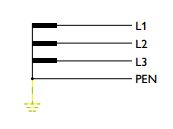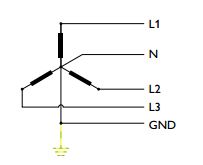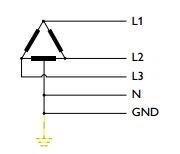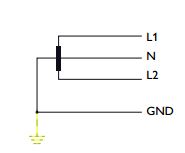Potential equalization
Potential equalization is used to create electrical connections between conductive components, in order to achieve potential equality. Furthermore, a conductive connection ensures equalization of charge differences between two bodies or components. All protective conductors and equipotential bonding conductors come together at the main earthing bar (PE bar) and are connected to the foundations earthing (steel reinforcement in concrete slabs) via the earthing conductor.
Potential equalization is also intended as protection against dangerous electrostatic discharge (ESD). To this end persons and equipment are connected to the foundation earthing through special devices to ensure that potential differences are rendered harmless.
This potential equalization can fulfil two different tasks in the electrical installation of a machine:
- ▪
- Personal protection against electric shock in the event of a fault in the machine or system, by means of a protective conductor system.
2. Functional potential equalization
- ▪
- To prevent malfunctions (as a result of shield faults) and to improve electromagnetic compatibility (EMC) of sensitive electronic components.
The following schematic diagram illustrates the purpose of potential equalization:
Potential equalization is also a “requirement for protection against electric shock”. It is specified in the international IEC 60364-4-41:2005 standard and the German DIN VDE 0100-410:2007-06 standard.
Connection of all conductive bodies (housings) of electrical components to a grounded protective conductor and the main earthing bar is the basis for protection against electric shock. The main protective measure specified in the VDE standard, i.e. automatic disconnection of the power supply in the event of a fault, is ensured through standard-compliant installation and subsequent testing of the system. The test also serves to verify adequately small loop impedance for automatic switch-off in the event of a fault.
The technical implementation of the potential equalization, the dimensioning of the cross-sections and the standardized terminology are specified in the international IEC 60364-5-54:2011 standard and the German DIN VDE 0100-540:2012-06 standard.
|
Separation of protective and neutral conductor! Please ensure that the network has separate protective (PE) and neutral (N) conductors and that the two conductors are not connected to the same potential (protective and neutral conductor = PEN). |
Mains systems
| |
| In a TN-C system the star point of all cables (L1, L2, L3 and PEN) is grounded directly. The neutral conductor (N) and the protective conductor (PE) are consolidated in a single conductor (PEN). In a three-phase power supply four cables are used, as shown in the sample on the left:
L1, L2, L3 and PEN. The following section describes TN-S systems, which are recommended by Beckhoff Automation GmbH & Co. KG from the perspective of Electro Magnetic Compatibility (EMC). |
| |
| Similar to a TN-C system, in a TN-S system the star point of all cables (L1, L2, L3, N and PE) is also grounded directly. The neutral conductor (N) and the protective conductor (PE) are connected separately to the consumer. In a three-phase power supply five cables are used, as shown in the sample on the left:
L1, L2, L3, N and PE. The transition from a TN-C system to a TN-S system is indicated with a blue cable. |
Wye system (Solidly Grounded Wye) | |
| In a Wye system the star point of all cables (L1, L2, L3, N and GND) is grounded and brought together in the center. In this mains system the protective earth conductor (GND) must not carry any current. The neutral conductor N (grounded conductor) must be separate and should only be tapped within the consumer system. In Germany TN-C-S mains systems are used. In many cases such systems are also used in the US as standard. In a three-phase power supply five cables are used, as shown in the sample on the left:
L1, L2, L3, optionally N and GND. |
Delta system (Corner Grounded Delta) | |
| In a delta system all connected components are grounded directly. This is done independent of the current source earthing. The protective earth conductor (GND) must not carry any current! The neutral conductor N (grounded conductor) must be separate and should only be tapped within the consumer system. Special measures, e.g. mains filters, must be applied in order to meet EMC requirements. These systems have no direct counterpart in the IEC standard. Earthing takes place either via one of the phases (Corner Grounded) or via a center tap between two phases (High-Leg). In a three-phase power supply five cables are used, as shown in the sample on the left:
L1, L2, L3, optionally N and GND. |
| |
| In a split-phase system earthing takes place via a center tap between the two phases. The neutral conductor is carried from there. In a three-phase power supply four cables are used, as shown in the sample on the left:
L1, N, L2 and GND. |
Potential differences:
- ▪
- Several spatially separated mounting plates within a control cabinet
- ▪
- Several control cabinets, which are spatially separated within the application
- ▪
- Operation of several local servo drives (AX5000 / AX8000)
- ▪
- Feeding of the control cabinet components from different suppliers
All potential differences result in leakage currents (potential equalization currents). For further information please refer to section: “Leakage currents” in the system manual for the AX5000 servo drive.
Potential differences also affect control and feedback signals, cause interference in communication devices and can render electronic components inoperable.
To reduce potential differences you have to:
- ▪
- Establish a potential equalization. Earthing straps with a large surface and a large contact area should be used for connecting unpainted mounting plates and control cabinets.
- ▪
- Establish a power supply with a common potential.
- ▪
- Provide large-surface shield connections.
Electrical safety and EMC considerations
- ▪
- From a personal protection measures (PPM) perspective, the PE bar in the control cabinet is used as star point.
- ▪
- From an EMC perspective, Beckhoff Automation GmbH & Co. KG recommends using the unpainted mounting plate in the control cabinet as star point for potential equalization.
| Conductor cross-sections for potential equalization cables The potential equalization cables should be as short as possible. The conductor cross-section should be rectangular and flat. The cross-section of your potential equalization cable must be adequately dimensioned. |
The following diagram shows an exemplary potential equalization configuration with different components. Note that potential equalization is application-specific, and the following sample should therefore not be regarded as a standard solution!
|
| Control cabinet door with earthing strap connection |
| DIN rail for component mounting |
| Unpainted mounting plate in the control cabinet |
| Earthing strap connection between PE bar and unpainted mounting plate |
| Large-surface cable duct connection |
| Cable duct made of sheet metal |
| Potential equalization between motor (OCT) and cable duct (HF-compatible) via flanged adapter plate |
| Separating bar in the cable duct for signal (green) and power cable (orange) |
| Potential equalization between machine frame and foundation earthing |
| Conductive connection of the metallic cable duct |
| Foundations earthing with steel reinforcement in the concrete slab |
| Earthing strap connection between control cabinet and foundation earthing |
| PE bar in the control cabinet |
| Installation of potential equalization Note the following when installing potential equalization: - •
- Protective conductor connection
Connect the control cabinet doors (1) to the control cabinet via a protective earth conductor cable (cross-section ≥ 10 mm² Cu).
Connect the mounting plate of the control cabinet (3) to the PE bar (13) via a protective earth conductor cable (cross-section ≥ 10 mm² Cu).
Connect the control cabinet to the foundation earthing (11) via a protective earth conductor cable (cross-section ≥ 10 mm² Cu). In addition, all cable ducts must connected to the control cabinet via a protective earth conductor cable (cross-section ≥ 10 mm² Cu).
- •
- Connection of motors and gear units
Connect all motors and gear units of your application to the metallic cable ducts via earthing straps.
- •
- Connection of metallic cable ducts
Metallic cable ducts should always be connected to each other over a large area.
The connections of the protective earth conductor cables should be a short as possible. All connections must be metallically pure! Never connect the protective conductors to painted surfaces! Clean all joints with a commercial industrial cleaner before connecting components.
|





